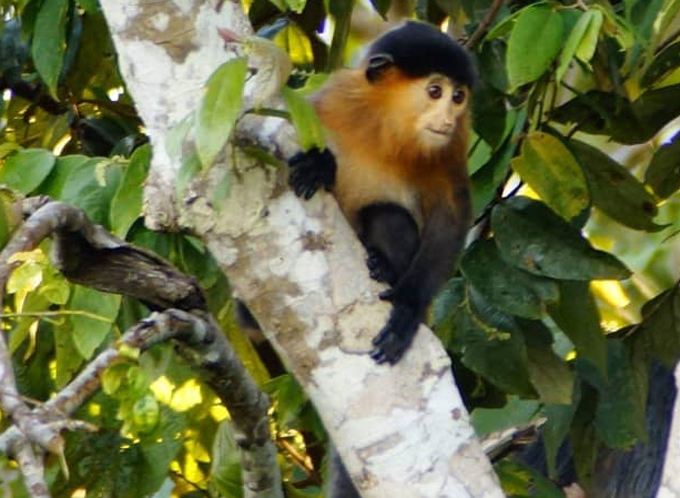‘Mystery monkey’ could mean its parent’s species may be in trouble
Some lost habitat may have pushed two species to mate when they otherwise wouldn’t have

This juvenile monkey (left) may be a rare hybrid. It’s being groomed by an adult female silvered leaf monkey, possibly its mom. The young monkey’s dad may be a proboscis monkey.
Ken S.H. Ching
A puzzling primate might be the offspring of two distantly related species. And this monkey business is worrying scientists.
Six years ago, tour guide Brenden Miles was traveling down the Kinabatangan River. He was on the Southeast Asian island of Borneo. This was in an area that’s part of Malaysia. Suddenly, he spotted an odd-looking primate. He snapped a few photos and looked at them later.
“At first, I thought it could be a morph of the silvered leaf monkey,” Miles says. A morph is a member of a species with a rare coloring. But then Miles noticed other details. The monkey’s tail was thicker than it should be. And its nose was long like that of a proboscis (Pro-BOSS-kiss) monkey. After posting a pic of the animal on Facebook, he forgot all about it.
Scientists have now studied that photo and others. They suspect this mystery monkey is a hybrid. That’s an animal born to parents of two different species. A male proboscis monkey (Nasalis larvatus) probably mated with a female silvered leaf monkey (Trachypithecus cristatus). Scientists are concerned that this could signal the creature’s parent species are in trouble.
Monkey mugshots
Sometimes closely related species hybridize. This happens only occasionally in the wild. What was especially surprising here: This monkey’s suspected parents are distant relatives.
When animals of different species hybridize, the parents both tend to belong to the same genus. That’s a group of closely related species. But the proboscis monkey and the silvered leaf monkey belong to different genera. “Hybridization across genera, that’s very rare,” says Ramesh Boonratana. He wasn’t part of this study. He teaches conservation biology at Mahidol University in Nakhon Pathom, Thailand.
Changes to the parent monkeys’ habitat might explain a hybrid, says Nadine Ruppert. She’s part of the team that studied the mystery monkey. A primatologist, she works in Malaysia at Universiti Sains Malaysia in Penang Island.
Ruppert’s team compared photos of the puzzling primate with images of the suspected-parent species. The scientists also sized up the mystery monkeys’ limbs based on the pictures. If the unknown animal was one of those two species, its measurements should be similar to one or the other. “But that is not the case with this animal,” Ruppert says.

The scientists aren’t completely sure yet about the mystery monkey’s ancestry. DNA in the primate’s poop could reveal if it indeed is the offspring of the two suspected species. So far, researchers haven’t been able to get close enough to nab a fecal sample.
But some other observations since 2016 bolster the idea that the mystery monkey might be a hybrid. Local tour guides have seen a proboscis male hanging around a troop of female silvered leaf monkeys. There’s even photo evidence of a male proboscis monkey mating with a female silvered leaf monkey.
Oil palm plantations have been expanding along the Kinabatangan River. As forests turn to farmland, wildlife habitats can be harmed or lost. Or they can be chopped into smaller pieces. The Kinabatangan River flows through the Malaysian state of Sabah. And this state lost about two-fifths of its forest cover from 1973 to 2010. Logging and oil palm plantations have been the main drivers of that loss.
In some spots, the suspected-parent monkey species have been squeezed into small patches of forest along that river, Ruppert says. Monkeys there could have to compete more for mates. In close quarters, she notes, the male of the bigger species can dominate. In this case, the proboscis male might easily displace males of the silvered leaf monkey.
A hybrid surprise
The mystery monkey is making people in the area pretty excited. “The hybrid is gorgeous,” Ruppert says. “But,” she adds, “we don’t want to see more of them.” Indeed, finding this monkey concerns her.
The International Union for Conservation of Nature creates the official global list of animals endangered with extinction. The group classifies proboscis monkeys as endangered. Silvered leaf monkeys are vulnerable to extinction, it says. Both species may lack enough food and space to behave as they would naturally, Ruppert says.
In Borneo and around the world, human activities and climate change are hurting animal habitats. As habitat is lost, mating (or at least attempts at mating) between different species — including different genera — might increase, Boonratana says.
The mystery monkey was last photographed in September 2020. It was holding a baby. Its breasts were swollen as well, which they would be when nursing young. That suggests that the primate is a fertile female. Hybrids tend to be sterile — unable to produce offspring. So here is yet another surprise from this unusual monkey.







